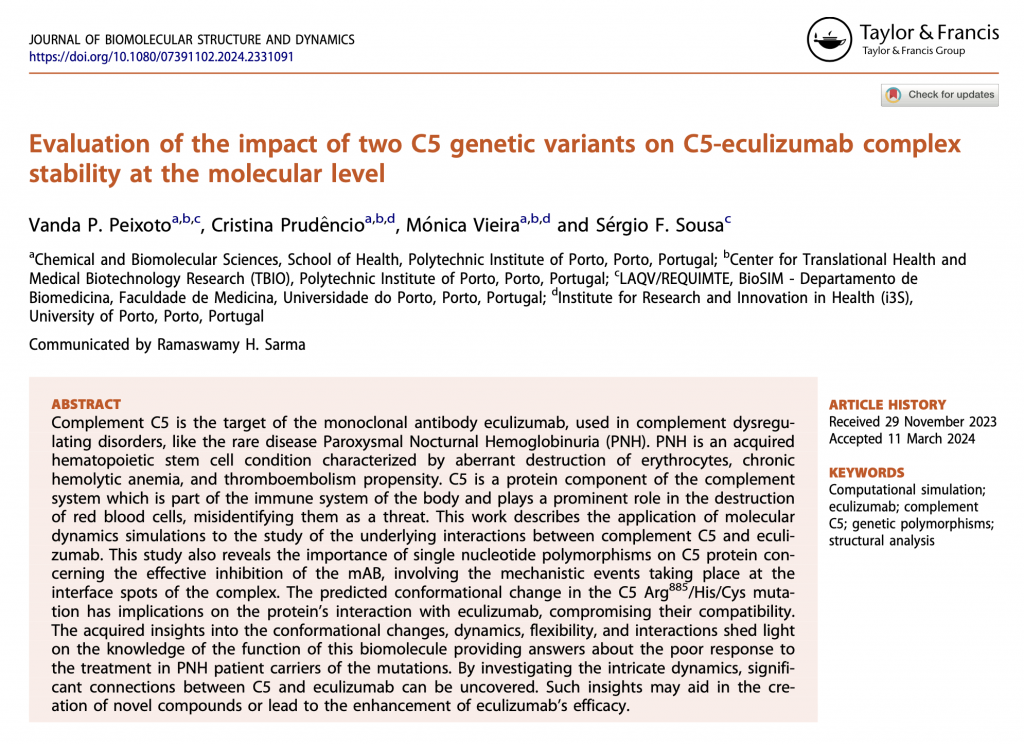Very happy to share our recent results obtained by our PhD Student Vanda Peixoto, with the supervision of Cristina Prudêncio (ESS-IPP), Mónica Vieira (ESS-IPP) and Sérgio F. Sousa (BioSIM) published in the Journal of Biomolecular Structure & Dynamics (IF 4.4).
In the treatment of rare blood disorders like Paroxysmal Nocturnal Hemoglobinuria (PNH), the monoclonal antibody eculizumab is used, targeting the complement C5 protein, a key player in the immune system’s misdirected attack on red blood cells. In this study, we have focused into the complex interactions between eculizumab and complement C5 through the lens of molecular dynamics simulations, offering a deeper understanding of their binding mechanisms.
In particular, our study highlights how specific genetic variations in the C5 protein, particularly the Arg885/His/Cys mutation, can hinder the effectiveness of eculizumab treatment, leaving some PNH patients with a poor response. By exploring the dynamic changes, flexibility, and interactions at the molecular level, this research not only enhances our comprehension of complement C5’s role but also paves the way for the development of more effective treatments.
Evaluation of the impact of two C5 genetic variants on C5-eculizumab complex stability at the molecular level
Vanda Peixoto, Cristina Prudêncio, Mónica Vieira, Sérgio F. Sousa
Journal of Biomolecular Structure & Dynamics (2024) | DOI: 10.1080/07391102.2024.2331091
Abstract:
Complement C5 is the target of the monoclonal antibody eculizumab, used in complement dysregulating disorders, like the rare disease Paroxysmal Nocturnal Hemoglobinuria (PNH). PNH is an acquired hematopoietic stem cell condition characterized by aberrant destruction of erythrocytes, chronic hemolytic anemia, and thromboembolism propensity. C5 is a protein component of the complement system which is part of the immune system of the body and plays a prominent role in the destruction of red blood cells, misidentifying them as a threat. This work describes the application of molecular dynamics simulations to the study of the underlying interactions between complement C5 and eculizumab. This study also reveals the importance of single nucleotide polymorphisms on C5 protein concerning the effective inhibition of the mAB, involving the mechanistic events taking place at the interface spots of the complex. The predicted conformational change in the C5 Arg885/His/Cys mutation has implications on the protein’s interaction with eculizumab, compromising their compatibility. The acquired insights into the conformational changes, dynamics, flexibility, and interactions shed light on the knowledge of the function of this biomolecule providing answers about the poor response to the treatment in PNH patient carriers of the mutations. By investigating the intricate dynamics, significant connections between C5 and eculizumab can be uncovered. Such insights may aid in the creation of novel compounds or lead to the enhancement of eculizumab’s efficacy.

